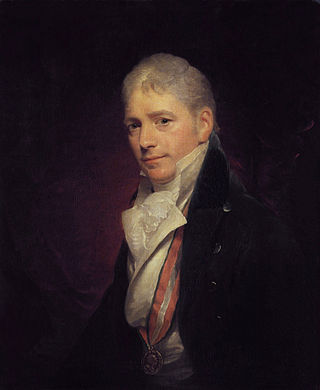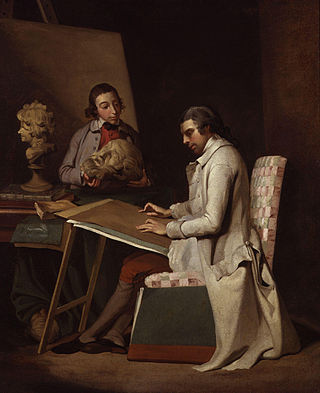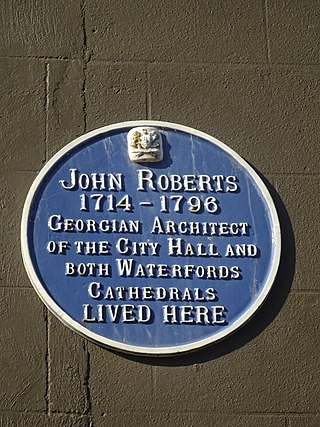
Thomas Gainsborough was an English portrait and landscape painter, draughtsman, and printmaker. Along with his rival Sir Joshua Reynolds, he is considered one of the most important British artists of the second half of the 18th century. He painted quickly, and the works of his maturity are characterised by a light palette and easy strokes. Despite being a prolific portrait painter, Gainsborough gained greater satisfaction from his landscapes. He is credited as the originator of the 18th-century British landscape school. Gainsborough was a founding member of the Royal Academy.

Giacomo Francesco Zuccarelli was an Italian artist of the late Baroque or Rococo period. He is considered to be the most important landscape painter to have emerged from his adopted city of Venice during the mid-eighteenth century, and his Arcadian views became popular throughout Europe and especially in England where he resided for two extended periods. His patronage extended to the nobility, and he often collaborated with other artists such as Antonio Visentini and Bernardo Bellotto. In 1768, Zuccarelli became a founding member of the Royal Academy of Arts, and upon his final return to Italy, he was elected president of the Venetian Academy. In addition to his rural landscapes which frequently incorporated religious and classical themes, Zuccarelli created devotional pieces and on occasion did portraiture. Besides paintings, his varied output included etchings, drawings, and designs for tapestries as well as a set of Old Testament playing cards.

Maria Anna Angelika Kauffmann, usually known in English as Angelica Kauffman, was a Swiss Neoclassical painter who had a successful career in London and Rome. Remembered primarily as a history painter, Kauffman was a skilled portraitist, landscape and decoration painter. She was, along with Mary Moser, one of two female painters among the founding members of the Royal Academy in London in 1768.

George Stubbs was an English painter, best known for his paintings of horses. Self-trained, Stubbs learnt his skills independently from other great artists of the 18th century such as Reynolds and Gainsborough. Stubbs' output includes history paintings, but his greatest skill was in painting animals, perhaps influenced by his love and study of anatomy. His series of paintings on the theme of a lion attacking a horse are early and significant examples of the Romantic movement that emerged in the late 18th century. He enjoyed royal patronage. His painting Whistlejacket hangs in the National Gallery, London.

Sir Peter Francis Lewis Bourgeois RA was an English landscape painter and history painter, and court painter to king George III of the United Kingdom.

George Barret Sr. was an Irish landscape artist known for his oil paintings and watercolours. He left Ireland in 1762 to establish himself as an artist in London and quickly gained recognition to become a leading artist of the period. He exhibited at the Society of Artists of Great Britain and was able to gain patronage from many leading art collectors. Barrett with other leading members left the Society in 1768 to found the Royal Academy, where he continued to exhibit until 1782.

Thomas Jones was a Welsh landscape painter. He was a pupil of Richard Wilson and was best known in his lifetime as a painter of Welsh and Italian landscapes in the style of his master. However, Jones's reputation grew in the 20th century when more unconventional works by him, not originally intended for exhibition, came to light. Most notable among these is a series of views of Naples which he painted from 1782 to 1783. By breaking with the conventions of classical landscape painting in favour of direct observation, they look forward to the work of Camille Corot and the Barbizon School in the 19th century. His autobiography, Memoirs of Thomas Jones of Penkerrig, went unpublished until 1951 but is now recognised as an important source of information on the 18th-century art world.

John Hamilton Mortimer was a British figure and landscape painter and printmaker, known for romantic paintings set in Italy, works depicting conversations, and works drawn in the 1770s portraying war scenes, similar to those of Salvator Rosa.[I]
Robert Carver was an Irish painter, who worked as a painter of theatre scenery as well as painting framed works. Carver was one of the leading landscape painters in the second half of eighteenth century Ireland.

Robert Home (1752–1834) was a British oil portrait painter who travelled to the Indian subcontinent in 1791. During his travels he also painted historic scenes and landscapes.

Robert Hunter was a portrait-painter and a native of Ulster. He studied under the elder Pope, and had a considerable practice in Dublin in the middle of the eighteenth century. He modelled his tone of colouring on the painting of old masters.

George Smith was an English landscape painter and poet, known as "George Smith of Chichester". He and his two brothers, all artists, are known as the "Smiths of Chichester".

Peter Toms RA was an English portrait and drapery painter, i.e. a painter specialising in depicting drapery for the works of other artists. He was a founding member of the Royal Academy. He was also the Portcullis Pursuivant at the College of Heralds.

Richard Wright was an English marine painter. An entirely self-taught artist, he first appeared as an exhibitor in London in 1760, and between that date and 1773 exhibited twenty-five works with the Incorporated Society of Artists and one with the Free Society.

Matthew Pratt was an American "Colonial Era" artist famous for his portraits of American men and women.
Thomas Sautelle Roberts was an Irish landscape artist.

Peter Mazell was an Irish painter and engraver, working in London between c. 1761 and 1797. He is known for his fine engravings of natural history subjects, especially those illustrating books by John Walcott and the Welsh naturalist Thomas Pennant. He created almost 600 engravings in his career. He also exhibited paintings of landscapes and flowers. He exhibited at the Society of Artists and at the Royal Academy.
John Hakewill was an English painter and interior decorator.

Richard Phelps (1710–1785) was an 18th-century English portrait painter and designer. He painted portraits of gentry, a number of which are in the National Trust, Dunster Castle, University of Oxford, National Portrait Gallery, London, and other museums. The British Museum has an album of 312 of his drawings. Phelps was also a landscape designer, who was hired by Henry Fownes Luttrell to update the grounds of Dunster Castle.

John Roberts was an Anglo-Irish architect of the 18th century, working in the Georgian style. Born in the city of Waterford, he is best known for the buildings he designed in that city.


















